have用法小结
have用法小结
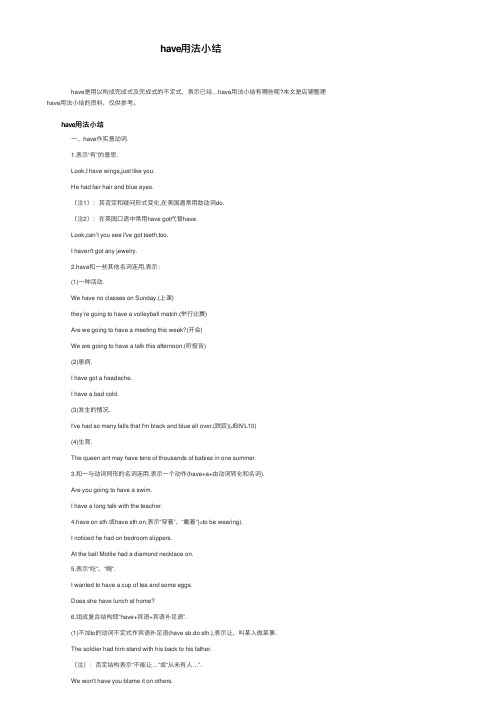
have⽤法⼩结 have是⽤以构成完成式及完成式的不定式,表⽰已经…have⽤法⼩结有哪些呢?本⽂是店铺整理have⽤法⼩结的资料,仅供参考。
have⽤法⼩结 ⼀、have作实意动词. 1.表⽰“有”的意思. Look,I have wings,just like you. He had fair hair and blue eyes. 〔注1〕:其否定和疑问形式变化,在美国通常⽤助动词do. 〔注2〕:在英国⼝语中常⽤have got代替have. Look,can’t you see I've got teeth,too. I haven't got any jewelry. 2.have和⼀些其他名词连⽤,表⽰: (1)⼀种活动. We have no classes on Sunday.(上课) they’re going to have a volleyball match.(举⾏⽐赛) Are we going to have a meeting this week?(开会) We are going to have a talk this afternoon.(听报告) (2)患病. I have got a headache. I have a bad cold. (3)发⽣的情况. I've had so many falls that I'm black and blue all over.(跌跤)(JBⅣL10) (4)⽣育. The queen ant may have tens of thousands of babies in one summer. 3.和⼀与动词同形的名词连⽤,表⽰⼀个动作(have+a+由动词转化和名词). Are you going to have a swim. I have a long talk with the teacher. 4.have on sth.或have sth.on,表⽰“穿着”、“戴着”(=to be wearing). I noticed he had on bedroom slippers. At the ball Motile had a diamond necklace on. 5.表⽰“吃”、“喝”. I wanted to have a cup of tea and some eggs. Does she have lunch at home? 6.组成复合结构即“have+宾语+宾语补⾜语”. (1)不加to的动词不定式作宾语补⾜语(have sb.do sth.),表⽰让、叫某⼈做某事. The soldier had him stand with his back to his father. 〔注〕:否定结构表⽰“不能让…”或“从未有⼈…”. We won't have you blame it on others. She had never had anybody speak to her that way before. (2)现在分词作宾语补⾜语(have sb.(sth.)doing),表⽰让(使)某⼈做某事. …the two men had their lights burning all night long…. (3)过去分词作宾语补⾜语(have sb.(sth.)done),表⽰: ①使(让,请)别⼈作某事,表⽰的动作是别⼈做的. Emperor Qin Shi Huang had all the walls joined up. …he should have new clothes made of this splendid cloth for the coming great procession. ②遭遇到某事. Houses near airports sometimes have their windows broken. Workers in some industries have their hearing harmed by the noise of the machine. ⼆、have与to⼀起构成情态动词,表⽰“不得不”、“必 须”,可⽤于各种时态. I have to look after her at home. 三、have做助动词与动词的过去分词⼀起构成现在完成时 和过去完成时. Great changes have taken place the last two years. They said that the Arab had stolen their camel. 四、have⽤于“情态动词+have+过去分词”的结构,有推测、假设之意. 1.must+have+过去分词,表⽰对过去时间发⽣的动作或存在的情况的推测,⼀般⽤于肯定句. Her father thought that she must have met a fairy. You must have left your bag in the theatre. 2.can(could)+have+过去分词,表⽰对过去发⽣事情的“不肯定”,常⽤于否定句和疑问句. He can't have been to your home,he doesn't know your address. 3.should+have+过去分词,表⽰“某事本该早做⽽实际未做”,⽤于肯定句. You should have been here five minutes ago. 五、have⽤于某些成语,表⽰固定的意思. 1.have a word(a few words)with sb.,表⽰和某⼈说⼀(⼏)句话. Where's Peter?I want to have a word with him. 2.had better+不带to的动词不定式,表⽰“…最好…”. I'd better go and look for him now. 3.have nothing(something)to do with,表⽰“和…⽆(有)”关系. Most of questions had nothing to do with Edison's lessons. 动词have的⽤法 动词have在中学英语中的⽤法 ⼀、have作实意动词。
have,has的用法

have,has的用法have和has是英语中常见的动词,它们表示"拥有"或者"持有"的意思。
这两个词根据主语的人称和数的不同形式有所变化:have用于第一、第二以及第三人称复数主语(I, you, we, they),以及第二人称单数主语(you),而has则用于第三人称单数主语(he, she, it)。
一、have和has的肯定句用法1. 拥有物体:have/has + 名词例如:- I have a car.(我有一辆车。
)- She has a cat. (她有一只猫。
)- They have two dogs. (他们有两只狗。
)2. 拥有特征、感觉或状态:have/has + 形容词例如:- We have a big house. (我们有一所大房子。
)- He has a lovely smile. (他有一个可爱的笑容。
)- She has a sore throat. (她喉咙痛。
)3. 持有某种位置: have/has + 介词短语例如:- They have a picnic in the park. (他们在公园里野餐。
)- He has a meeting at 2 p.m. (他下午两点有个会议。
)二、have和has的否定句用法1. 在肯定句中加入否定词not构成否定句例如:- I do not have a car. (我没有汽车。
)- She does not have a cat. (她没有猫。
)- They do not have two dogs. (他们没有两只狗。
)2. 在肯定句的缩略形式中,常用haven't 和 hasn't例如:- I haven't seen him today. (我今天还没见到他。
)- She hasn't finished her homework. (她还没有做完作业。
have的用法小结
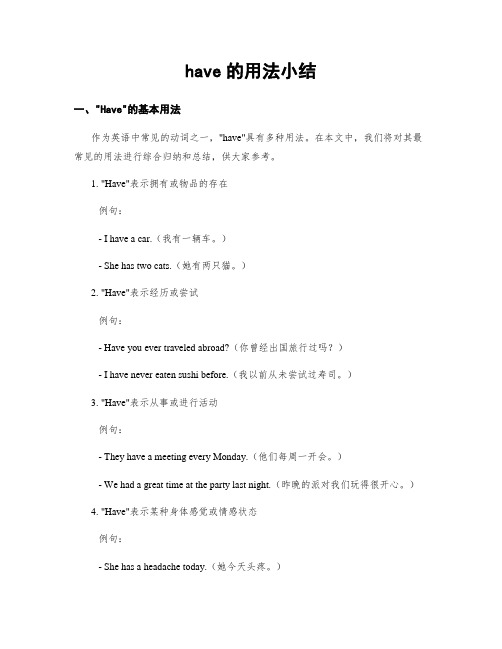
have的用法小结一、"Have"的基本用法作为英语中常见的动词之一,"have"具有多种用法。
在本文中,我们将对其最常见的用法进行综合归纳和总结,供大家参考。
1. "Have"表示拥有或物品的存在例句:- I have a car.(我有一辆车。
)- She has two cats.(她有两只猫。
)2. "Have"表示经历或尝试例句:- Have you ever traveled abroad?(你曾经出国旅行过吗?)- I have never eaten sushi before.(我以前从未尝试过寿司。
)3. "Have"表示从事或进行活动例句:- They have a meeting every Monday.(他们每周一开会。
)- We had a great time at the party last night.(昨晚的派对我们玩得很开心。
)4. "Have"表示某种身体感觉或情感状态例句:- She has a headache today.(她今天头疼。
)- He had a feeling of excitement when he heard the good news.(当他听到好消息时,他有一种兴奋的感觉。
)5. "Have"作为助动词形式例句:- She has been studying English for three years.(她已经学了三年英语了。
)- Have you finished your homework yet?(你的作业做完了吗?)二、"Have"的常见短语和惯用搭配除了以上基本用法外,"have"还有一些常见的短语和惯用搭配,让我们一起来了解一下。
1. "Have to"在表示义务、责任或需要时使用,意为“必须”。
have的用法及搭配
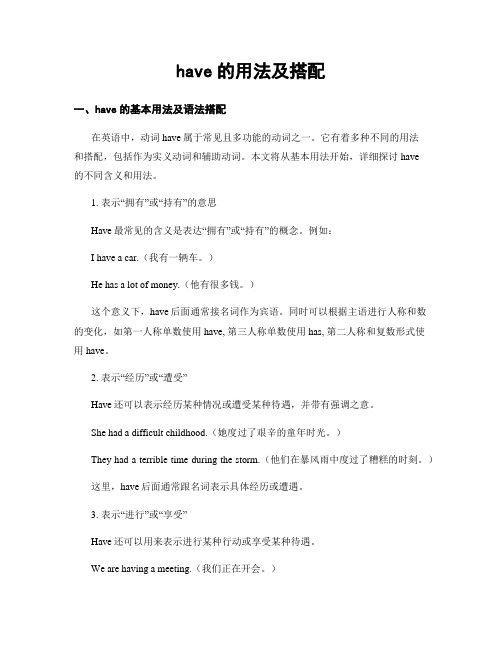
have的用法及搭配一、have的基本用法及语法搭配在英语中,动词have属于常见且多功能的动词之一。
它有着多种不同的用法和搭配,包括作为实义动词和辅助动词。
本文将从基本用法开始,详细探讨have的不同含义和用法。
1. 表示“拥有”或“持有”的意思Have最常见的含义是表达“拥有”或“持有”的概念。
例如:I have a car.(我有一辆车。
)He has a lot of money.(他有很多钱。
)这个意义下,have后面通常接名词作为宾语。
同时可以根据主语进行人称和数的变化,如第一人称单数使用have, 第三人称单数使用has, 第二人称和复数形式使用have。
2. 表示“经历”或“遭受”Have还可以表示经历某种情况或遭受某种待遇,并带有强调之意。
She had a difficult childhood.(她度过了艰辛的童年时光。
)They had a terrible time during the storm.(他们在暴风雨中度过了糟糕的时刻。
)这里,have后面通常跟名词表示具体经历或遭遇。
3. 表示“进行”或“享受”Have还可以用来表示进行某种行动或享受某种待遇。
We are having a meeting.(我们正在开会。
)I had a great time at the party.(我在派对上度过了愉快的时光。
)此时,have后面通常跟动词的现在分词形式作宾语。
4. 表示“发生”或“出现”Have也可以用来描述事件、情况或感觉的发生或出现。
I had a strange dream last night.(昨晚我做了一个奇怪的梦。
)She had a sudden memory of the accident.(她突然回想起那次事故。
)这种情况下,have后面通常用名词表示具体事件、情况或感觉。
5. 表示时间和日期Have在口语中还可用来指定具体时间和日期。
We're having dinner at 7 o'clock tonight.(今晚七点我们要吃晚饭。
Have的用法讲解
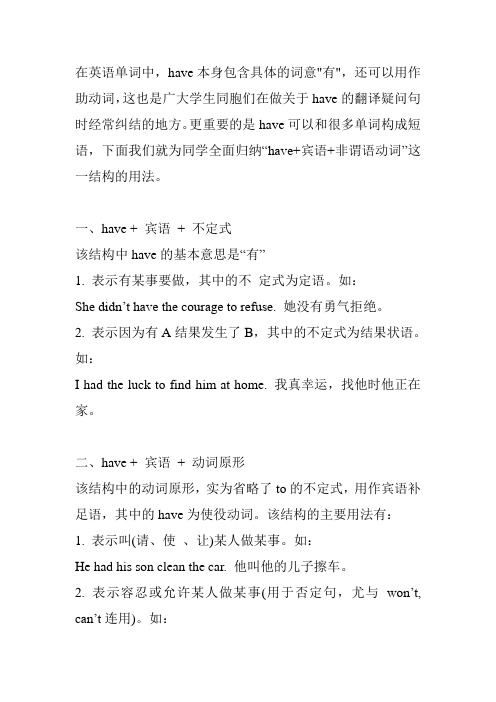
在英语单词中,have本身包含具体的词意"有",还可以用作助动词,这也是广大学生同胞们在做关于have的翻译疑问句时经常纠结的地方。
更重要的是have可以和很多单词构成短语,下面我们就为同学全面归纳“have+宾语+非谓语动词”这一结构的用法。
一、have + 宾语+ 不定式该结构中have的基本意思是“有”1. 表示有某事要做,其中的不定式为定语。
如:She didn’t have the courage to refuse. 她没有勇气拒绝。
2. 表示因为有A结果发生了B,其中的不定式为结果状语。
如:I had the luck to find him at home. 我真幸运,找他时他正在家。
二、have + 宾语+ 动词原形该结构中的动词原形,实为省略了to的不定式,用作宾语补足语,其中的have为使役动词。
该结构的主要用法有:1. 表示叫(请、使、让)某人做某事。
如:He had his son clean the car. 他叫他的儿子擦车。
2. 表示容忍或允许某人做某事(用于否定句,尤与won’t, can’t连用)。
如:I won’t have you tell me what to do. 我不能让你对我做的事指手划脚。
三、have + 宾语+ 现在分词该结构中的现在分词用作宾语补足语,其中的have为使役动词。
该结构的主要用法有:1. 表示使(让)某人(某事物)一直做在做某事或处于做某事的状态之中。
如:She had her audience listening attentively. 她使听众听得入神。
2. 表示容忍或允许某人做某事(用于否定句,尤与won’t, can’t连用)。
如:I won’t have you smoki ng at your age. 我不能让你在这个年纪就抽烟。
3. 说服或命令某人做某事。
如:He had me doing all kinds of jobs for her. 他叫我为她做各种事情。
have 用法
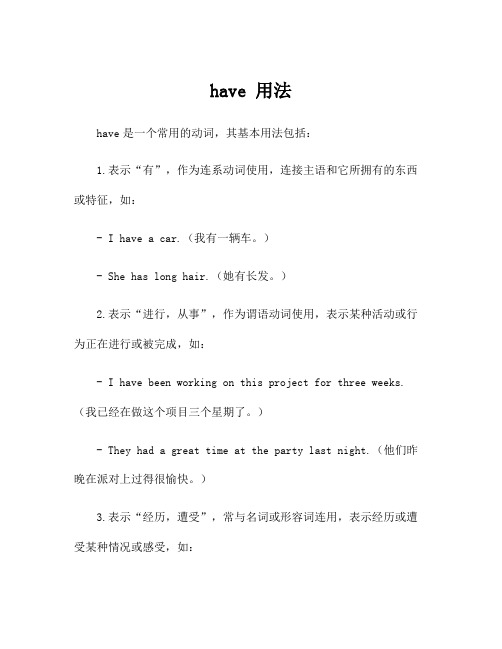
have 用法have是一个常用的动词,其基本用法包括:1.表示“有”,作为连系动词使用,连接主语和它所拥有的东西或特征,如:- I have a car.(我有一辆车。
)- She has long hair.(她有长发。
)2.表示“进行,从事”,作为谓语动词使用,表示某种活动或行为正在进行或被完成,如:- I have been working on this project for three weeks.(我已经在做这个项目三个星期了。
)- They had a great time at the party last night.(他们昨晚在派对上过得很愉快。
)3.表示“经历,遭受”,常与名词或形容词连用,表示经历或遭受某种情况或感受,如:- She has had a difficult year.(她度过了一个艰难的一年。
)- He had a terrible headache yesterday.(昨天他头疼得厉害。
)除了以上基本用法外,have还有很多其他用法和搭配,如:- have to:表示“必须,不得不”,作为情态动词使用,后接动词原形,如:I have to go to work.(我得去上班。
)- have got:表示“有”,口语中常用的一种表达方式,与have同义,如:She's got a new job.(她有了一份新工作。
)- have for breakfast/lunch/dinner:表示“吃什么早餐/午餐/晚餐”,如:What did you have for breakfast this morning?(今天早上你吃了什么早餐?)总之,have是一个多功能的动词,需要根据不同的语境和搭配进行理解和使用。
英语中have用法总结

英语中have用法总结篇一:have用法小结have 的用法小结一、have作实意动词。
1.表示“有”的意思。
Look, I have wings, just like you. (JBⅤL1)He had fair hair and blue eyes. (JBⅥL2) 〔注1〕:其否定和疑问形式变化,在美国通常用助动词do。
〔注2〕:在英国口语中常用have got代替have.Look, can’t you see I've got teeth, too,(JBⅤL1)I haven't got any jewelry.(SBⅠL5)2.have和一些其他名词连用,表示:(1)一种活动。
We have no classes on Sunday.(上课)(JBⅡL11)they’re going to have a volleyball match.(举行比赛)(JBⅢL11) Are we going to have a meeting this week?(开会)(JBⅢL11)We are going to have a talk this afternoon.(听报告)(JBⅢL11)(2)患病。
I have got a headache.(JBⅣL8)I have a bad cold.(JBⅤL3)(3)发生的情况。
I've had so many falls that I'm black and blue all over.(跌跤)(JBⅣL10)(4)生育。
The queen ant may have tens of thousands of babies in one summer.(SBⅠL14)3.和一与动词同形的名词连用,表示一个动作(have+a+由动词转化和名词)。
Are you going to have a swim.(JBⅢL1)I have a long talk with the teacher.(JBⅣL10)4.have on sth.或have sth. on,表示“穿着”、“戴着”(=to be wearing)。
have的三种用法归纳

have的三种用法归纳嘿,同学们!今天咱们要来聊聊“have”这个单词,它在英语里可是个活跃分子,用法还挺多,咱们重点瞧瞧它常见的三种用法。
先来说说“have”表示“拥有”的意思。
比如说,“I have a pen”(我有一支笔。
)这就很直接,表明我拥有一支笔。
再比如,“She has a beautiful dress”(她有一条漂亮的裙子。
)这里的“has”是“have”的第三人称单数形式,因为主语是“she”,得用这个形式。
我记得有一次,我在教室里批改作业,听到两个同学在那讨论。
一个同学说:“I have many friends”另一个同学马上反驳道:“You are so lucky But I don’t have as many as you” (你真幸运。
但我没有你那么多。
)他们俩那认真的模样,让我忍不住笑了。
这就是“have”表示“拥有”在生活中的常见运用。
“have”还能用来表示“吃、喝”。
“Have some coffee”(喝点咖啡。
)“Have lunch”(吃午饭。
)这时候,它就和咱们平常说的“eat”“drink”有相似的意思啦。
想起有一回,我去朋友家做客。
到了饭点,朋友热情地说:“Come and have dinner with us” (来和我们一起吃晚饭。
)我欣然答应,那顿晚餐吃得特别温馨。
最后一种常见用法,“have”可以表示“进行、举办”。
像“have a party”(举办派对),“have a meeting”(开会)。
就说前段时间,我们学校组织活动,老师说:“We are going to have a sports meeting next week”(我们下周要开运动会。
)同学们一听,都兴奋得不行,纷纷开始准备。
同学们,“have”的这三种用法可得记牢啦,在日常的英语交流和写作中经常会用到。
多练习,多运用,相信你们能把“have”用得溜溜的!加油哦!。
- 1、下载文档前请自行甄别文档内容的完整性,平台不提供额外的编辑、内容补充、找答案等附加服务。
- 2、"仅部分预览"的文档,不可在线预览部分如存在完整性等问题,可反馈申请退款(可完整预览的文档不适用该条件!)。
- 3、如文档侵犯您的权益,请联系客服反馈,我们会尽快为您处理(人工客服工作时间:9:00-18:30)。
have 的用法小结一、have作实意动词。
1.表示“有”的意思。
Look, I have wings, just like you. (JBⅤL1)He had fair hair and blue eyes. (JBⅥL2) 〔注1〕:其否定和疑问形式变化,在美国通常用助动词do。
〔注2〕:在英国口语中常用have got代替have.Look, can’t you see I've got teeth, too,(JBⅤL1)I haven't got any jewelry.(SBⅠL5)2.have和一些其他名词连用,表示:(1)一种活动。
We have no classes on Sunday.(上课)(JBⅡL11)they’re going to have a volleyball match.(举行比赛)(JBⅢL11)Are we going to have a meeting this week?(开会)(JBⅢL11)We are going to have a talk this afternoon.(听报告)(JBⅢL11)(2)患病。
I have got a headache.(JBⅣL8)I have a bad cold.(JBⅤL3)(3)发生的情况。
I've had so many falls that I'm black and blue all over.(跌跤)(JBⅣL10)(4)生育。
The queen ant may have tens of thousands of babies in one summer.(SBⅠL14)3.和一与动词同形的名词连用,表示一个动作(have+a+由动词转化和名词)。
Are you going to have a swim.(JBⅢL1)I have a long talk with the teacher.(JBⅣL10)4.have on sth.或have sth. on,表示“穿着”、“戴着”(=to be wearing)。
I notice d he had on bedroom slippers.(SBⅡL6)At the ball Motile had a diamond necklace on.5.表示“吃”、“喝”。
I wanted to have a cup of tea and some eggs.(JBⅢL10)Does she have lunch at home?(JBⅡL11)6.组成复合结构即“have+宾语+宾语补足语”。
(1)不加to的动词不定式作宾语补足语(have sb. do sth.),表示让、叫某人做某事。
The soldier had him stand with his back to his father.(SBⅠL17)〔注〕:否定结构表示“不能让…”或“从未有人…”.We won't have you blame it on others.She had never had anybody speak to her that way before.(2)现在分词作宾语补足语(have sb.(sth.)doing),表示让(使)某人做某事。
…the two men had their lights burning all night long….(3)过去分词作宾语补足语(have sb. (sth.)done),表示:①使(让,请)别人作某事,表示的动作是别人做的。
Emperor Qin Shi Huang had all the walls joined up.(SBⅠL10)…he should have n ew clothes made of this splendid cloth for the coming great procession.(SBⅠL8)②遭遇到某事。
Houses near airports sometimes have their windows broken.(SBⅠL12)Workers in some industries have their hearing harmed by the noise of the machine.(SBⅠL12) 二、have与to一起构成情态动词,表示“不得不”、“必须”,可用于各种时态。
I have to look after her at home.(JBⅢL4)三、have做助动词与动词的过去分词一起构成现在完成时和过去完成时。
Great changes have taken place the last two years.(JBⅥL3)They said that the Arab had stolen their camel.(JBⅤL4)四、have用于“情态动词+have+过去分词”的结构,有推测、假设之意。
1.must+have+过去分词,表示对过去时间发生的动作或存在的情况的推测,一般用于肯定句。
Her father thought that she must have met a fairy.(SBⅠL10)You must have left your bag in the theatre.2.can(could)+have+过去分词,表示对过去发生事情的“不肯定”,常用于否定句和疑问句。
He can't have been to your home, he doesn't know your address.3.should+have+过去分词,表示“某事本该早做而实际未做”,用于肯定句。
You should have been here five minutes ago.(SBⅡL10)五、have用于某些成语,表示固定的意思。
1.have a word(a few words)with sb.,表示和某人说一(几)句话。
Where's Peter? I want to have a word with him.(SBⅢL13)2.had better+不带to的动词不定式,表示“…最好…”。
I'd better go and look for him now.(JBⅢL2)3.have nothing(something)to do with,表示“和…无(有)”关系。
Most of questions had nothing to do with Edison's lessons.动词have是中学英语课本中出现频率较高的一个普通单词。
它既可以作及物动词,也可以用作助动词,其基本意义是“有、拿、受、取、吃、喝、让……”。
大多数同学对have表示某人或某物拥有某物的用法比较熟悉。
例如:I have a new pencil-box.He has two coats.A desk has four lezs.但对have的使役用法却知之甚少,或者说对这种用法掌握得还不太好。
下面就让我们通过例句来阐明动词have的使役用法。
请看下面的例句:1.He had me mend his bike.他请我给他修理自行车。
2.The old man had a small house built, for him.那位老人让人为他建一个小房子。
3.The naughty boy may have me hit.那个调皮的男孩可能会让人打我。
4.The teacher had the naughty boy standing outside the classroom.老师叫那位调皮的男孩站在教室外面。
5.I have my friend waiting for me.我有朋友在等着我。
6.You should have her here.你应该要她到这里来。
上述例句中的have表示“使、让、请”等意思。
除例6中的have之外,其他例句中的have都失去了它原来的“具有”、“拥有”之慈。
便役动词have的这类用法可以大致归纳为如下几种句式:A.have sb do sthB.have sth or sb doneC.have sb or sth doingD.have sb or sth+adv以上四种句式有一个共同点,就是have后都接了一个复合宾语结构,而不同之处就在这个复合宾语结构的构成上,当然意义是各不相同的。
句式A:have sb do sth,其意为“要(请)某人干某事”,宾语是人,宾语补足语是不带to的不定式。
句式B:have sth or sb done,其意是:“使某事(由某人)来完成”,或“使某人被……”。
宾语一般是物,也可以是人,宾语补足语是过去分词。
句式c:have sb or sth doing,其意是“允许某人(物)做某事”,另外一层意思是“有某人(物)在干某事”。
宾语可以是人,也可以是物,宾语补足语为现在分词。
句式D:have sb or sth+adv,可以看作是句式A、B的变形,只是把动词原形或过去分词省略了。
宾语可以是人,也可以是物,宾语补足语是副词(表示地点或方向的)。
句式A和句式B所表达的意思基本相同,只是前者强调的是人(让某人做某事),后者强调的是物(“使某事由某人来做”),此时行为者可以不出现。
请分析并比较下面的例句:Please have the boys sweep the road.Please have the road swept (by the boys).请让那些男孩打扫一下马路。
Mr Wang will have his students clean the desks in the classroom.Mr Warg will have the desks cleaned(by his students)in theclassroom.王先生要他的学生来擦洗教室里的课桌。
句式A和句式B中的have都可以用get来代替,但是用get代替句式A中的have时,宾语补足语要用带t0的不定式,即get sb to do sth。
例如上面两个例句可写成:Please get the .boys to fweep the road.Mr whng will get his students to clean thedesks in the classroom.但在表示理发时要特别注意,应该是:You ought to have(get) your hair cut.根据以上所述,句式C有两层意思:①有人(物)在做某事;②许可某人(物)做某事。
